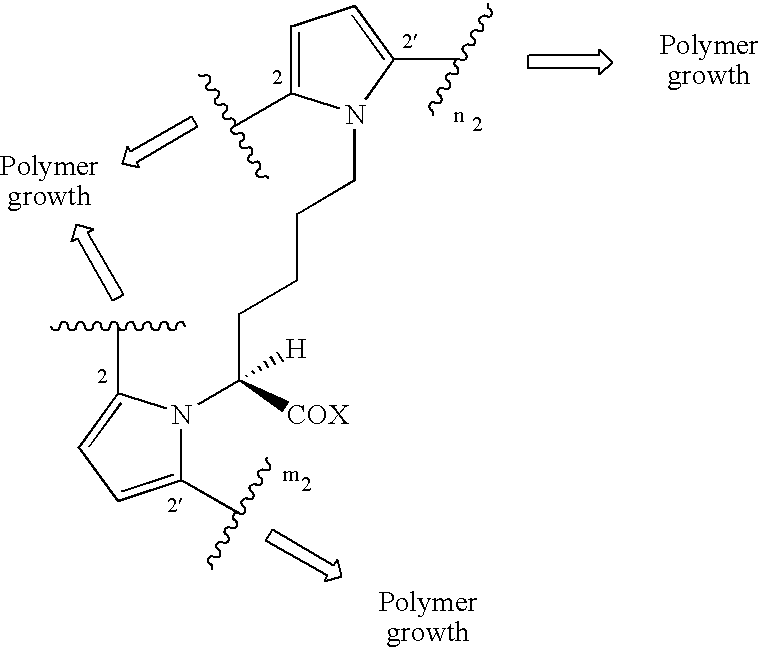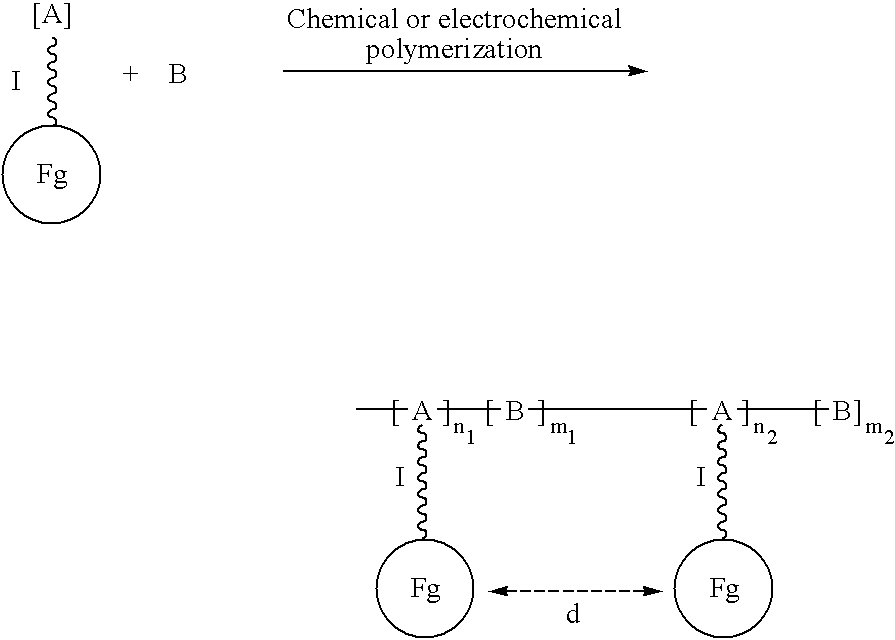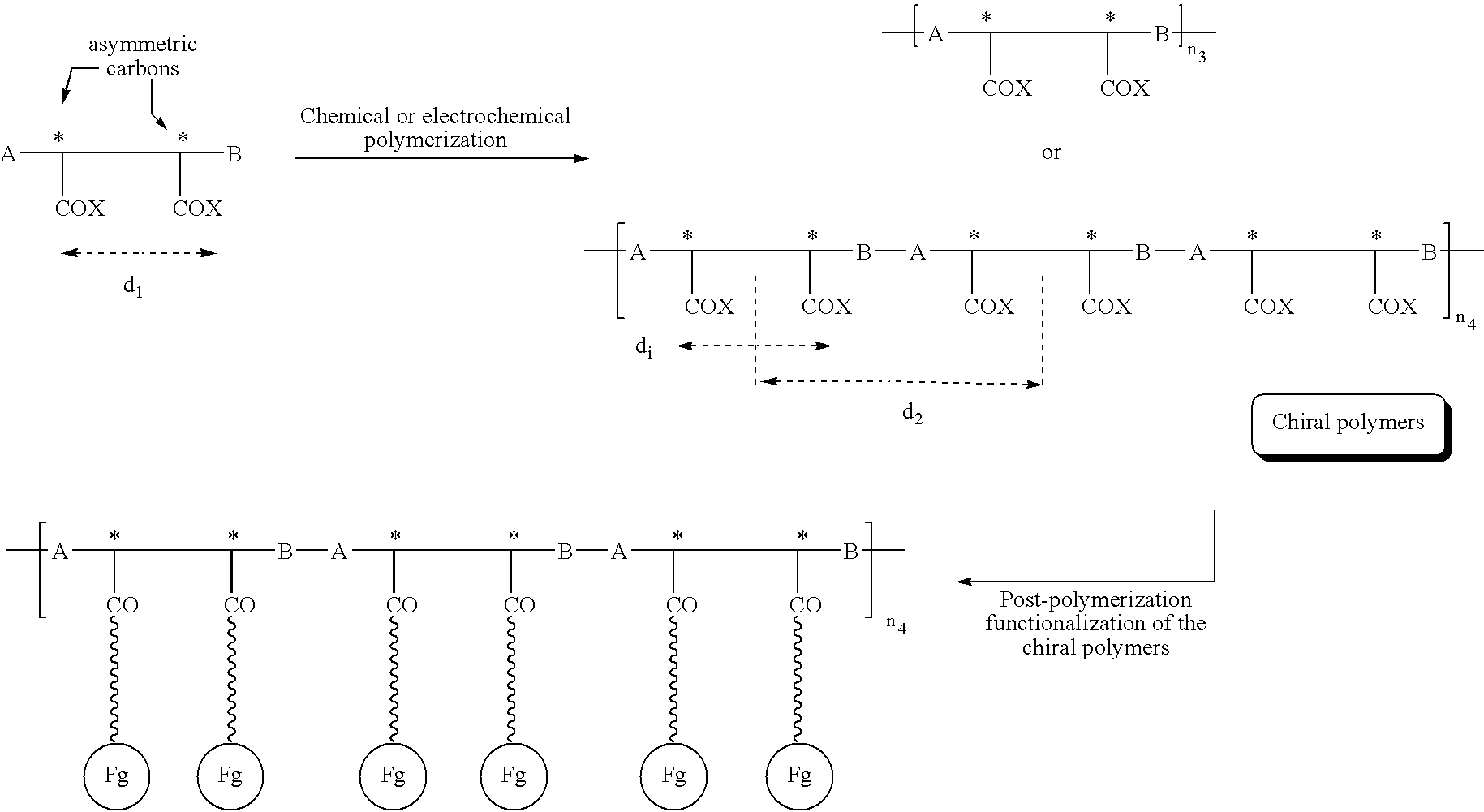Electroconductive polymers
a technology of electroconductive polymers and polymers, applied in the field of chemistry, can solve the problems of reducing the activity of entrapped enzymes, difficult access of analytes to immobilized proteins, and macromolecules not providing homopolymerization
- Summary
- Abstract
- Description
- Claims
- Application Information
AI Technical Summary
Benefits of technology
Problems solved by technology
Method used
Image
Examples
example 1
Preparation of a Chiral Dipyrrole Polymerizable Monomer
Scheme of Synthesis of Optically Active (L)-2,6-dipyrrole-1-yl-hexanoic acid
[0117]
Reagents:0.822g4.5mmolL-Lysine monohydrochioride1.31mL10.2mmol2,5-Dimethoxytetrahydrofuran0.7384g9.0mmolSodium acetate4.95mLWater2.475mLAcetic acid8.0mL1,2-Dichloroethane
A Typical Experimental Protocol
(Entry 5 of the Hereunder Table of Complementary Results):
[0118]2,5-Dimethoxytetrahydrofuran (DMT, 1.31 mL, 10.2 mmol) dissolved in 1,2-dichloroethane (3.0 mL) is added dropwise, during 2 hours, under a nitrogen atmosphere, to a round bottom flask (50 mL) containing the following biphasic mixture of L-lysine monohydrochloride (0.822 g, 4.5 mmol), sodium acetate (0.7384 g, 9.0 mmol), acetic acid (2.475 mL), 1,2-dichloroethane (5.0 mL) and water (4.95 mL). The medium is refluxed during 4 hours at 76° C. After cooling, a saturated solution of ammonium chloride is added to the solution mixture (30.0 mL). The aqueous solution is then extracted with diethyl...
example 2
Preparation of a C2-Symetrical Chiral Dipyrrole Polymerizable Monomer Synthesis of (LL)-Cysteine Dipyrrole Dimethyl Ester
Scheme of Synthesis of Optically Active (LL)-Cystine Dipyrrole Dimethyl Ester
[0129]
Reagents0.343g1.0mmolL-Cystine dimethyl ester ester (2 HCl)0.29mL2.23mmol2,5-Dimethoxytetrahydrofuran0.1674g2.0mmolSodium acetate1.1mLDistilled water0.55mLAcetic acid1.66mL1,2-Dichloroethane
A Typical Experimental Protocol:
[0130]2,5-Dimethoxytetrahydrofuran (DMT, 0.29 mL, 2.23 mmol) was added to around bottom flask (50 mL) containing the following biphasic mixture of L-Cystine dimethyl ester dihydrochloride 98% purity (Aldrich, 0.343 g, 1.0 mmol), sodium acetate (0.1674 g, 2.0 mmol), acetic acid (0.55 mL), 1,2-dichloroethane (1.66 mL) and distilled water (1.1 mL). The medium is refluxed during 4 hours at 76° C. under a nitrogen atmosphere. After cooling to room temperature, dichlormethane (198 mL) is added to the reaction mixture. The separated organic layer is then extracted with wa...
example 3
COOH-Polypyrrole / Polycarbazole Paramagnetic Nanocomposite Particles: Standard Robust Experimental Protocols
[0137]The magnetite paramagnetic nanoparticles were prepared acccording to modifications of the standard aqueous precipitation technique of Fe2+ and Fe3+ ions from a basic solution (I. R. Massart, IEEE Trans. Magn. 1981, 17: p. 131). Aqueous solutions of FeCl3 (160.0 mg, 3.0 ml H2O) and FeCl2 (65.0 mg, 3.0 ml H2O, concentrations ratio 2:1) were mixed at 20° C. and the reaction mixture placed in an ultrasonic water bath. Aqueous ammonium hydroxide (32% 0.3 ml) was added slowly in one portion. A black suspension of magnetite was immediately formed. Following an equilibration period of about 1 minute at room temperature (pH 9), the magnetite nanoparticles were washed several times with distilled water using magnetic decantation till neutrality, and stored in distilled water (magnetite concentration: 16.1 mg / ml suspension, average particle diameter: 10-16 n...
PUM
| Property | Measurement | Unit |
|---|---|---|
| molecular weights | aaaaa | aaaaa |
| particle diameter | aaaaa | aaaaa |
| concentration | aaaaa | aaaaa |
Abstract
Description
Claims
Application Information
 Login to View More
Login to View More - R&D
- Intellectual Property
- Life Sciences
- Materials
- Tech Scout
- Unparalleled Data Quality
- Higher Quality Content
- 60% Fewer Hallucinations
Browse by: Latest US Patents, China's latest patents, Technical Efficacy Thesaurus, Application Domain, Technology Topic, Popular Technical Reports.
© 2025 PatSnap. All rights reserved.Legal|Privacy policy|Modern Slavery Act Transparency Statement|Sitemap|About US| Contact US: help@patsnap.com



